【清华课件】工程材料(A)CH14-SME-EngMater-英文版
合集下载
工程材料学介绍英语ppt
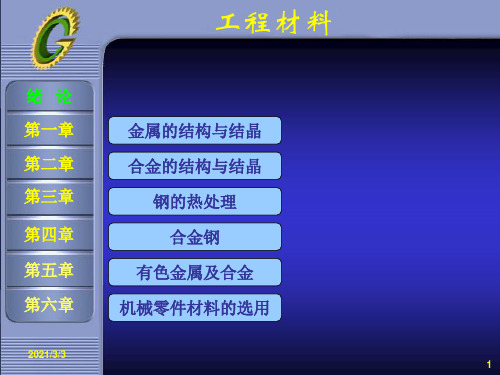
绪论
布氏硬度 HB ( Brinell-hardness ) 适用范围
➢ <450HBS(钢球) ➢ <650HBW(硬质合金) HB与 之间的关系 退火态 低中碳钢
调质态 低中碳钢
15
绪论 第一章 第二章 第三章 第四章 第五章 第六章
2021/3/3
绪论
洛氏硬度 HR ( Rockwll hardness)
试样屈服时的载荷( N )
试样原始横截面积( mm2)
2021/3/3 13
绪论 第一章 第二章 第三章 第四章 第五章 第六章
2021/3/3
绪论
注意:
除了塑性较好的材料在拉伸试验中有明显的屈 服现象外,大多材料的屈服现象并不十分明显,所 以工程上常规定塑变量为0.2%的值作为屈服极限, 记为:
汽车用材概况:
86%
10% 4%
机床用材概况:
91%
5% 4%
金属材料 橡胶 玻璃、塑料
金属材料 其它 橡胶、塑料
2021/3/3 5
绪论 第一章 第二章 第三章 第四章 第五章 第六章
2021/3/3
在机械工业中,目前用量最大 的仍是金属材料,几乎占了工 程材料总量的90%多 。
6
绪论
绪论 第一章 第二章 第三章 第四章 第五章 第六章
δ > 10% 塑性材料
2021/3/3 17
绪论 第一章 第二章 第三章 第四章 第五章 第六章
绪论
2 疲劳强度和冲击韧性
1)疲劳强度( fatigue strength ) 表示材料经无数次交变载荷 作用而不致引起断裂的最大 应力值。
107
N
钢材的循环次数一般取 N = 107
清华大学-工程材料课件(1).136页文档

清华大学-工程材料课件(1).
36、如果我们国家的法律中只有某种 神灵, 而不是 殚精竭 虑将神 灵揉进 宪法, 总体上 来说, 法律就 会更好 。—— 马克·吐 温 37、纲纪废弃之日,便是暴政兴起之 时。— —威·皮 物特
38、若是没有公众舆论的支持,法律 是丝毫 没有力 量的。 ——菲 力普斯 39、一个判例造出另一个判例,它们 迅速累 聚,进 而变成 法律。 ——朱 尼厄斯
40、人类法律,事物有规律6、书不仅是生活,而且是现在、过 去和未 来文化 生活的 源泉。 ——库 法耶夫 57、生命不可能有两次,但许多人连一 次也不 善于度 过。— —吕凯 特 58、问渠哪得清如许,为有源头活水来 。—— 朱熹 59、我的努力求学没有得到别的好处, 只不过 是愈来 愈发觉 自己的 无知。 ——笛 卡儿
拉
60、生活的道路一旦选定,就要勇敢地 走到底 ,决不 回头。 ——左
36、如果我们国家的法律中只有某种 神灵, 而不是 殚精竭 虑将神 灵揉进 宪法, 总体上 来说, 法律就 会更好 。—— 马克·吐 温 37、纲纪废弃之日,便是暴政兴起之 时。— —威·皮 物特
38、若是没有公众舆论的支持,法律 是丝毫 没有力 量的。 ——菲 力普斯 39、一个判例造出另一个判例,它们 迅速累 聚,进 而变成 法律。 ——朱 尼厄斯
40、人类法律,事物有规律6、书不仅是生活,而且是现在、过 去和未 来文化 生活的 源泉。 ——库 法耶夫 57、生命不可能有两次,但许多人连一 次也不 善于度 过。— —吕凯 特 58、问渠哪得清如许,为有源头活水来 。—— 朱熹 59、我的努力求学没有得到别的好处, 只不过 是愈来 愈发觉 自己的 无知。 ——笛 卡儿
拉
60、生活的道路一旦选定,就要勇敢地 走到底 ,决不 回头。 ——左
清华大学工程材料第五版第二章PPT学习教案

4. 电磁搅拌 将正在结晶的金属置于一个交变电磁场中 ,由于电磁感应现象,液态金属翻滚,冲断 正在结晶的树枝状晶体的晶枝,增加结晶核 心,细化晶粒。
第20页/共29页
2.1.4 铸锭的结构
一、铸锭结构
铸锭分为三个各具特征的晶区。
1. 细等轴晶区
锭2. 模柱温状度晶低区,导热快,
外层细3.液晶粗体形等金成轴属,晶过锭区冷模度温大度,升
金属在固态下随温度的改变,由一种晶格转 变为另一种晶格的现象,称为同素异构转变 。
第11页/共29页
纯铁的同素异构转变: ●液态纯铁在1538℃结
晶为体心立方晶格的δ-Fe
。 ●冷却到1394℃时发生 同素异构转变, 成为面心 立方晶格的γ-Fe。
●冷却到912℃时又发 生一次同素异构转变, 成
为体心立方晶格的α-Fe。
曲率线和实随成多长的长际着核,大左大晶工过速速边速粒程冷率 度部 度细中度NG分都小,的快大。增;过增,,大晶冷大结,粒度,晶成粗常成后核。处核晶速于速粒 率增大更快,比值N/G也增大
, 晶粒细化。
成核速率、长大速度 与过冷度的关系
第17页/共29页
增大过冷度的主要方法: 提高液态金属的冷却速度。 采用冷却能力较强的模子。 采用金属型铸模, 比采用砂型铸模获得的铸 件晶粒要细小。 超高速急冷技术可获得超细化晶粒的金属 、亚稳态结构的金属和非晶态结构的金属。 非晶态金属具有特别高的强度和韧性、优 异的软磁性能、高的电阻率、良好的抗蚀性 等。
清华大学工程材料第五版第二章
会计学
1
学习目标:
本章是工程材料课程的重点章。 着重掌握:铁碳相图,铁碳合金的平衡结 晶过程,铁碳合金的成分-组织-性能关系。过 冷奥氏体的转变,钢的淬透性、淬硬性。常用 热处理等热处理工艺。合金元素对钢的热处理 、钢的机械性能的影响。 熟悉纯金属、合金的结晶,金属的塑性加 工、再结晶对金属组织和性能的影响规律。 表面技术部分作一般了解。
第20页/共29页
2.1.4 铸锭的结构
一、铸锭结构
铸锭分为三个各具特征的晶区。
1. 细等轴晶区
锭2. 模柱温状度晶低区,导热快,
外层细3.液晶粗体形等金成轴属,晶过锭区冷模度温大度,升
金属在固态下随温度的改变,由一种晶格转 变为另一种晶格的现象,称为同素异构转变 。
第11页/共29页
纯铁的同素异构转变: ●液态纯铁在1538℃结
晶为体心立方晶格的δ-Fe
。 ●冷却到1394℃时发生 同素异构转变, 成为面心 立方晶格的γ-Fe。
●冷却到912℃时又发 生一次同素异构转变, 成
为体心立方晶格的α-Fe。
曲率线和实随成多长的长际着核,大左大晶工过速速边速粒程冷率 度部 度细中度NG分都小,的快大。增;过增,,大晶冷大结,粒度,晶成粗常成后核。处核晶速于速粒 率增大更快,比值N/G也增大
, 晶粒细化。
成核速率、长大速度 与过冷度的关系
第17页/共29页
增大过冷度的主要方法: 提高液态金属的冷却速度。 采用冷却能力较强的模子。 采用金属型铸模, 比采用砂型铸模获得的铸 件晶粒要细小。 超高速急冷技术可获得超细化晶粒的金属 、亚稳态结构的金属和非晶态结构的金属。 非晶态金属具有特别高的强度和韧性、优 异的软磁性能、高的电阻率、良好的抗蚀性 等。
清华大学工程材料第五版第二章
会计学
1
学习目标:
本章是工程材料课程的重点章。 着重掌握:铁碳相图,铁碳合金的平衡结 晶过程,铁碳合金的成分-组织-性能关系。过 冷奥氏体的转变,钢的淬透性、淬硬性。常用 热处理等热处理工艺。合金元素对钢的热处理 、钢的机械性能的影响。 熟悉纯金属、合金的结晶,金属的塑性加 工、再结晶对金属组织和性能的影响规律。 表面技术部分作一般了解。
【清华课件】工程材料(A)CH15-SME-EngMater-英文版
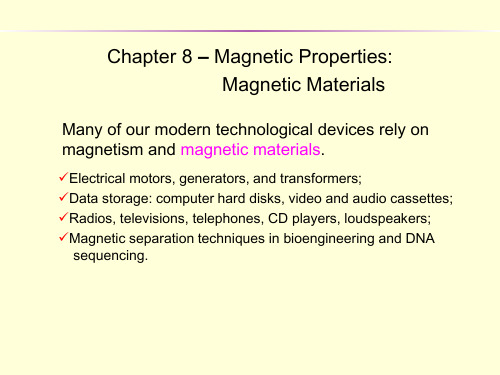
Chapter 8 – Magnetic Properties: Magnetic Materials
Many of our modern technological devices rely on magnetism and magnetic materials.
✓Electrical motors, generators, and transformers; ✓Data storage: computer hard disks, video and audio cassettes; ✓Radios, televisions, telephones, CD players, loudspeakers; ✓Magnetic separation techniques in bioengineering and DNA
strong, m as high as 106
• Antiferromagnetism: Mn, Cr, MnO, NiO; very weak.
Induced dipoles
Permanent dipoles
• Ferrimagnetism: ceramics (ferrites): MFe2O4, or M2+O2--(Fe3+)2(O2-)3.
✓Favorably oriented domains grow at the expense of unfavorable ones, and finally rotate to become a single domain that is nearly aligned with the field.
✓ Exist below Tc (Curie temperature: 768C, 1120C, 335C, and 585C for Fe, Co, Ni, and Fe3O4, respectively);
Many of our modern technological devices rely on magnetism and magnetic materials.
✓Electrical motors, generators, and transformers; ✓Data storage: computer hard disks, video and audio cassettes; ✓Radios, televisions, telephones, CD players, loudspeakers; ✓Magnetic separation techniques in bioengineering and DNA
strong, m as high as 106
• Antiferromagnetism: Mn, Cr, MnO, NiO; very weak.
Induced dipoles
Permanent dipoles
• Ferrimagnetism: ceramics (ferrites): MFe2O4, or M2+O2--(Fe3+)2(O2-)3.
✓Favorably oriented domains grow at the expense of unfavorable ones, and finally rotate to become a single domain that is nearly aligned with the field.
✓ Exist below Tc (Curie temperature: 768C, 1120C, 335C, and 585C for Fe, Co, Ni, and Fe3O4, respectively);
【清华课件】工程材料(A)CH13-SME-EngMater-英文版
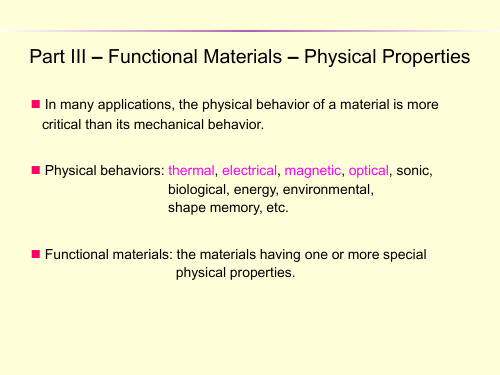
dT/dx - the temperature gradient through the conducting medium.
Physical behaviors: thermal, electrical, magnetic, optical, sonic, biological, energy, environmental, shape memory, etc.
Functional materials: the materials having one or more special physical properties.
For isotropic materials, v = 3l
• Thermal expansion: an increase in the average distance between the atoms.
• The greater the atomic bonding energy, the smaller the value of l is.
Weakly bonded solids
Low melting point Low elastic modulus High thermal-expansion coefficient
Strongly bonded solids
High melting point High elastic modulus Low thermal-expansion coefficient
13.3 Thermal Conductivity
• Thermal conductivity: the ability of a material to transfer heat.
where q - the heat flux, or heat flow, per unit time per unit area, k - the thermal conductivity (W/m-K),
Physical behaviors: thermal, electrical, magnetic, optical, sonic, biological, energy, environmental, shape memory, etc.
Functional materials: the materials having one or more special physical properties.
For isotropic materials, v = 3l
• Thermal expansion: an increase in the average distance between the atoms.
• The greater the atomic bonding energy, the smaller the value of l is.
Weakly bonded solids
Low melting point Low elastic modulus High thermal-expansion coefficient
Strongly bonded solids
High melting point High elastic modulus Low thermal-expansion coefficient
13.3 Thermal Conductivity
• Thermal conductivity: the ability of a material to transfer heat.
where q - the heat flux, or heat flow, per unit time per unit area, k - the thermal conductivity (W/m-K),
CH4_2014_EngMater_Lecture1
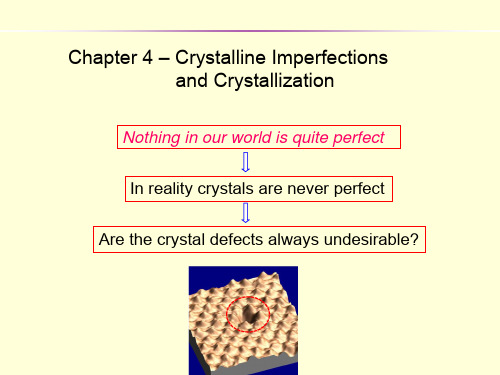
Local lattice distortion (compression)
In bcc -Fe, max. octahedral void radius=0.036 nm.
Interstitial solid solution (e.g., C dissolved in Fe, forming Fe(C) solid solution)
Crystalline Imperfections in Metals: Linear Defects - General Dislocations:
One-dimensional defects around which atoms are misaligned; Lattice distortions are centered around a line.
Three-dimensional defects are actually forming a noncrystalline structure.
Crystalline Imperfections in Metals: Point Defects – Vacancy, Self-interstitial
Crystalline Imperfections in Metals: Linear Defects – Screw Dislocation Screw dislocation: left screw; right screw
A spiral planar ramp resulting from shear deformation.
Crystalline Imperfections in Metals: Point s–Substitutional Atoms
Lattice distortion (Tension or Compression)
In bcc -Fe, max. octahedral void radius=0.036 nm.
Interstitial solid solution (e.g., C dissolved in Fe, forming Fe(C) solid solution)
Crystalline Imperfections in Metals: Linear Defects - General Dislocations:
One-dimensional defects around which atoms are misaligned; Lattice distortions are centered around a line.
Three-dimensional defects are actually forming a noncrystalline structure.
Crystalline Imperfections in Metals: Point Defects – Vacancy, Self-interstitial
Crystalline Imperfections in Metals: Linear Defects – Screw Dislocation Screw dislocation: left screw; right screw
A spiral planar ramp resulting from shear deformation.
Crystalline Imperfections in Metals: Point s–Substitutional Atoms
Lattice distortion (Tension or Compression)
材料科学与工程专业英语课件

• These alloy additions are chosen carefully because they invariably bring with them sharply increased material costs. They are justified only by essential improvements in properties such as higher strength or improved corrosion resistance
1.1.1 Iron and Steel
The iron ore which we find on earth is not pure. It contains some impurities that must be removed by smelting. The process of smelting consists of heating the ore in a blast furnace with coke and limestone, and reducing it to metal. Blasts of hot air enter the furnace from the bottom and provide the oxygen that is necessary for the reduction of the ore.
1.1.1 Iron and Steel
• We can melt this down again in another furnace-a cupola-with more coke and limestone, and tap it out into a ladle or directly into molds. This is cast iron. Cast iron does not have the strength of steel. It is brittle and may fracture under tension.
1.1.1 Iron and Steel
The iron ore which we find on earth is not pure. It contains some impurities that must be removed by smelting. The process of smelting consists of heating the ore in a blast furnace with coke and limestone, and reducing it to metal. Blasts of hot air enter the furnace from the bottom and provide the oxygen that is necessary for the reduction of the ore.
1.1.1 Iron and Steel
• We can melt this down again in another furnace-a cupola-with more coke and limestone, and tap it out into a ladle or directly into molds. This is cast iron. Cast iron does not have the strength of steel. It is brittle and may fracture under tension.
工程材料课件 (Engineering Materials)

– 应变 (strain):单位长度的伸长量,用试样的伸长量 除以试样的原始标距表示。
拉伸试验机
拉伸试验的颈缩现象
应力
应变
低碳钢的应力-应变曲线
弹性和刚度
– 弹性 (Elasticity):金属材料受外力作用时产生变形, 当外力去掉后能恢复到原来形状及尺寸的性能。
– 弹性变形:随载荷撤除而消失的变形。
– 抗拉强度 b(Breaking strength):试样在断裂前所能承受的最
大应力。
– 屈服强度和抗拉强度是零件设计的重要依据,也是评定金属 强度的重要指标之一。
塑性 (Plasticity)
– 在载荷作用下产生塑性变形而不被破坏的能力。
– 伸长率δ:是指试样拉断后的标距伸长量与原始标距之比。 – 断面收缩率ψ:试样拉断处横截面积的收缩量与原始横截面积
高分子材料
– 又称聚合物,包括天然高分子材料(木材、棉、麻 等)和合成高分子材料(塑料,合成橡胶等)。其 主要组分高分子化合物是有许多结构相同的结构单 元相互连接而成。它具有较高的强度、良好的塑性、 较强的耐腐蚀性、绝缘性和低密度等优良性能。高 分子材料发明虽晚,但异军突起,因其物美价廉, 在工程材料中应用越来越广。
本课程的研究内容
– 主要研究机械工程上所用的结构材料,主要偏重于 金属材料。
– 研究金属材料的组织、结构及其与机械性能和工艺 性能之间的关系。
第一章 材料的性能(properties)
材料的力学性能(mechanical properties)
– 定义:指材料在不同环境(温度、介质)下,承受 各种外加载荷(拉伸、压缩、弯曲、扭转、冲击、 交变应力等)时所表现出的力学特征。
多晶体示意图
多晶体示意图
拉伸试验机
拉伸试验的颈缩现象
应力
应变
低碳钢的应力-应变曲线
弹性和刚度
– 弹性 (Elasticity):金属材料受外力作用时产生变形, 当外力去掉后能恢复到原来形状及尺寸的性能。
– 弹性变形:随载荷撤除而消失的变形。
– 抗拉强度 b(Breaking strength):试样在断裂前所能承受的最
大应力。
– 屈服强度和抗拉强度是零件设计的重要依据,也是评定金属 强度的重要指标之一。
塑性 (Plasticity)
– 在载荷作用下产生塑性变形而不被破坏的能力。
– 伸长率δ:是指试样拉断后的标距伸长量与原始标距之比。 – 断面收缩率ψ:试样拉断处横截面积的收缩量与原始横截面积
高分子材料
– 又称聚合物,包括天然高分子材料(木材、棉、麻 等)和合成高分子材料(塑料,合成橡胶等)。其 主要组分高分子化合物是有许多结构相同的结构单 元相互连接而成。它具有较高的强度、良好的塑性、 较强的耐腐蚀性、绝缘性和低密度等优良性能。高 分子材料发明虽晚,但异军突起,因其物美价廉, 在工程材料中应用越来越广。
本课程的研究内容
– 主要研究机械工程上所用的结构材料,主要偏重于 金属材料。
– 研究金属材料的组织、结构及其与机械性能和工艺 性能之间的关系。
第一章 材料的性能(properties)
材料的力学性能(mechanical properties)
– 定义:指材料在不同环境(温度、介质)下,承受 各种外加载荷(拉伸、压缩、弯曲、扭转、冲击、 交变应力等)时所表现出的力学特征。
多晶体示意图
多晶体示意图
机械工程材料双语教学PPT讲解

26
1.2.5 Fatigue Strength 疲劳强度
3)疲劳断裂的特点
① 断裂时的应力远低于材料静载下的抗拉强度,甚至屈服强度,
疲劳断裂属低应力脆断;
② 断裂是突然发生的,不产生明显的塑性变形,是一种无预兆、
突然发生的断裂,因此危险性极大。 4)疲劳断裂的基本过程
① 裂纹产生:材料本身的缺陷和 结构等原因,使零件受力时局部产生应 力集中,形成疲劳裂纹源,达到一定条 件时,产生裂纹。
韧性向脆性的转变
In these materials the fracture behaviors is ductile at high tem-
perature and brittle at low temperature.
22
1.2.4 Toughness 韧性 冲击韧性 a. 一般来说,低碳钢和低强度钢的韧脆转变温度较低且比较 明显;而高碳钢和高强度钢看不出明显的韧脆转变温度 b. 为避免脆性破坏,多采用0.20% C以下的低碳钢。钢中加 入锰、镍等元索,可使韧脆转变温度降低。
低碳钢的拉伸图
屈服点(S) :如继续增大外力,超过s点时,拉伸曲线上就出现 了近似水平的线段,此时试棒所受外力虽不再增加,但变形却继 续增加,这种现象称为“屈服”,S点称为屈服点。
7
(一)屈服强度(σ s )
材料产生屈服现象时的应力为材料的屈服强度,单位为MPa
s
Fs A
(MPa)
Fs——试棒产生屈服时所承受的最大外力(N) A——试棒原始截面面积(mm2)
3
1.2.1 Elastic Deformation 弹性变形 • Young’s Modulus (Elastic Modulus) 弹性模量
1.2.5 Fatigue Strength 疲劳强度
3)疲劳断裂的特点
① 断裂时的应力远低于材料静载下的抗拉强度,甚至屈服强度,
疲劳断裂属低应力脆断;
② 断裂是突然发生的,不产生明显的塑性变形,是一种无预兆、
突然发生的断裂,因此危险性极大。 4)疲劳断裂的基本过程
① 裂纹产生:材料本身的缺陷和 结构等原因,使零件受力时局部产生应 力集中,形成疲劳裂纹源,达到一定条 件时,产生裂纹。
韧性向脆性的转变
In these materials the fracture behaviors is ductile at high tem-
perature and brittle at low temperature.
22
1.2.4 Toughness 韧性 冲击韧性 a. 一般来说,低碳钢和低强度钢的韧脆转变温度较低且比较 明显;而高碳钢和高强度钢看不出明显的韧脆转变温度 b. 为避免脆性破坏,多采用0.20% C以下的低碳钢。钢中加 入锰、镍等元索,可使韧脆转变温度降低。
低碳钢的拉伸图
屈服点(S) :如继续增大外力,超过s点时,拉伸曲线上就出现 了近似水平的线段,此时试棒所受外力虽不再增加,但变形却继 续增加,这种现象称为“屈服”,S点称为屈服点。
7
(一)屈服强度(σ s )
材料产生屈服现象时的应力为材料的屈服强度,单位为MPa
s
Fs A
(MPa)
Fs——试棒产生屈服时所承受的最大外力(N) A——试棒原始截面面积(mm2)
3
1.2.1 Elastic Deformation 弹性变形 • Young’s Modulus (Elastic Modulus) 弹性模量
ENGINEERING MATERIALS 工程材料简介(中英对照)
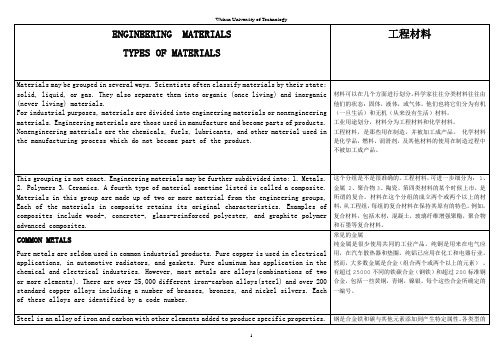
This grouping is not exact. Engineering materials may be further subdivided into: 1. Metals. 2. Polymers 3. Ceramics. A fourth type of material sometime listed is called a composite. Materials in this group are made up of two or more material from the engineering groups, Each of the materials in composite retains its original characteristics. Examples of composites include wood-, concrete-, glass-reinforced polyester, and graphite polymer advanced composites.
物理性能;
力学性能;
化学性质;
热性能;
电器及磁学性质;
光学性质;
声学特性。
1.Physical Properties
Physical properties, for this discussion, are restricted to those which describe the basic features of the material. These features are measured or observed without the use of extensive scientific experiments. The common physical properties are size, shape, density, and porosity.
物理性能;
力学性能;
化学性质;
热性能;
电器及磁学性质;
光学性质;
声学特性。
1.Physical Properties
Physical properties, for this discussion, are restricted to those which describe the basic features of the material. These features are measured or observed without the use of extensive scientific experiments. The common physical properties are size, shape, density, and porosity.
- 1、下载文档前请自行甄别文档内容的完整性,平台不提供额外的编辑、内容补充、找答案等附加服务。
- 2、"仅部分预览"的文档,不可在线预览部分如存在完整性等问题,可反馈申请退款(可完整预览的文档不适用该条件!)。
- 3、如文档侵犯您的权益,请联系客服反馈,我们会尽快为您处理(人工客服工作时间:9:00-18:30)。
14.3 Semiconductors: Intrinsic
• Effect of temperature on intrinsic semiconductivity:
increases with T, opposite to metals.
n = p = n0 exp(-Eg /2KT) = n0e(e+h)exp(-Eg/2KT) ln = ln0 - Eg/2KT Where K – Boltamann’s constant
14.3 Semiconductors: Intrinsic
• Intrinsic semiconductors:
✓Pure semiconducting materials: elemental: Si, Ge (both in group IA); compound: IIIA-VA compounds (GaAs, GaP, GaSb, InSb, InAs, InP) IIB-VIA compounds (CdS, CdSe, ZnSe, CdTe, ZnTe).
(energy-band structure, temperature, impurities, etc.)
✓the mobility of charge carriers.
(scattering centers: crystal imperfections, phonons)
• Energy-band structures:
Fermi energy Ef : the energy of the highest filled state at 0 K. Free electrons: those with energies greater than Ef Excitation energy: provided by heat (T) or light.
14.1 Electrical Conductivity: Energy-Band Structures at 0 K
Conductors: Cu, etc.
Conductors: Mg, etc. Insulators: typical Eg > 4 eV.
Semiconductors: typical Eg < 4 eV.
Conduction band: empty, lowest unoccupied energy levels.
Conduction band
Valence band: filled, highest occupied energy levels
Aggregate of 12 atoms
Splitting of energy levels occurs upon close interatomic approach.
Chapter 14 – Electrical Properties: Electronic Materials
Electrical properties: the responses of materials to an
applied electric field.
Electronic materials
Intrinsic silicon
Disadvantage of intrinsic semiconductors:
is significantly influenced by temperature.
✓ decreases with increasing temperature, impurities, and plastic deformation.
n e e
where n - the number of free electrons per unit volume; e (m2/V.s) – the electron mobility;
✓Electrical conductivity is determined by their inherent electronic structure:
n e e p e h n=p (typically 1.51016/m3, for Si at R.T.)
GaAs is the most important of all the compound semiconductors and is used in many electronic devices (higher electron mobility and larger band gap for a better radiation resistance as compared to Si). Good for space and military uses. But its cost is higher.
Superconductors Conductors
Semiconductors
Insulators
Elemental Compound Organic Inorganic
14.1 Electrical Conductivity: General
• Charge carriers:
✓Free electrons: dominant for most solids;
✓Holes: in semiconductors;
✓ Electrical conductivity, [(.m)-1], is proportional to:
✓the number of charge carriers available;
14.1 Electrical Conductivity: Classifications
(>105, typical 107) (10-4 -104)
(10-16 -10-5)
14.2 Electrical Properties of Metals - Conductors
✓ Good conductors of electricity: Ag, Cu, Au, Al, ….;
